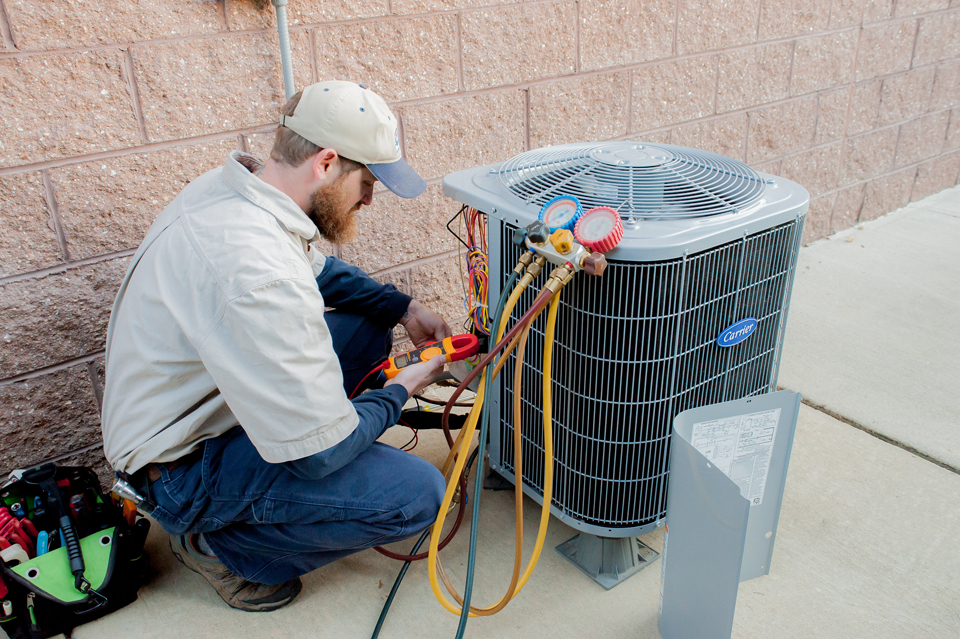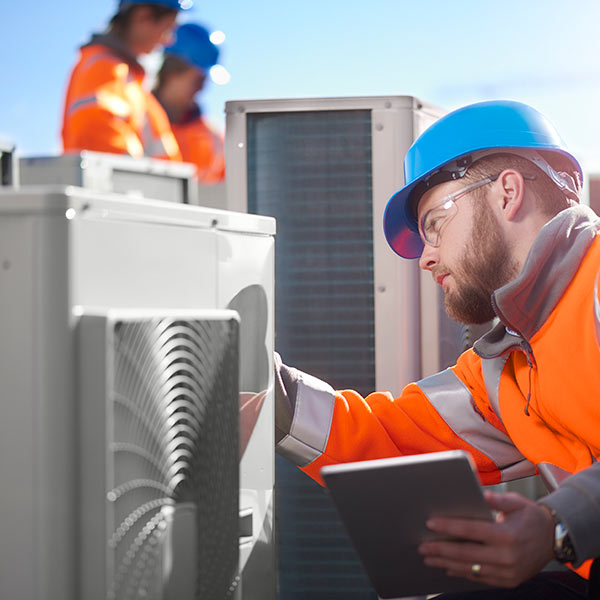How to Save on Your furnace replacement Project
How to Save on Your furnace replacement Project
Blog Article
Just How a Heatpump and Heater Work Together to Maximize Your Home's Home heating Performance
Understanding how a heat pump and heater work together is vital for homeowners seeking effective heating services. Each system has its toughness, offering a well balanced strategy to home comfort. The heatpump masters moderate temperatures, while the heater provides rapid heat during severe cold. This synergy not only decreases power expenses yet likewise boosts the life expectancy of both devices. What variables affect this collaboration, and exactly how can house owners maximize their benefits?
Recognizing Heat Pumps: Exactly How They Work
Although numerous people might be unknown with their inner operations, warmth pumps play an important role in modern furnace. These gadgets run by moving warmth from one location to another, using the principles of thermodynamics. In colder months, a warm pump essences warmth from the outdoors air, ground, or water, and transfers it inside to warm the living room. On the other hand, during warmer months, it can reverse the procedure, acting as an ac system by removing warmth from inside to the outside.Heat pumps contain an evaporator, expansion, compressor, and condenser shutoff. The refrigerant within the system absorbs heat as it evaporates at reduced temperatures and pressures. The compressor after that increases the stress and temperature of the cooling agent, allowing it to launch warmth as it condenses. This effective process can substantially reduce power intake contrasted to typical heating approaches, making heat pumps a lasting selection for climate control in homes.
The Function of Furnaces in Home Home Heating
Furnaces play a vital role in home heating by providing a trustworthy source of warmth during the cooler months. They run by producing heat through burning or electric resistance, distributing it throughout the home using ducts or radiant systems. The performance of a heater is usually gauged by its Yearly Gas Utilization Efficiency (AFUE) ranking, which suggests just how effectively the device converts fuel right into heat.Furnaces can make use of different energy resources, consisting of gas, electrical power, lp, or oil, permitting property owners to select the most appropriate option for their requirements. Unlike heat pumps, which may have a hard time in extreme cool, heating systems preserve consistent efficiency, making sure that indoor temperatures remain comfy despite outdoor conditions. Additionally, contemporary heating systems frequently come outfitted with advanced modern technology, such as smart thermostats and variable-speed blowers, boosting their effectiveness and responsiveness. This flexibility makes furnaces a vital part in all-inclusive home heating approaches.

Advantages of Utilizing Both Solutions Together
Integrating the toughness of both heating systems and heat pumps can bring about a much more reliable and effective home heating solution. Using both systems allows homeowners to capitalize on the heatpump's energy performance throughout milder temperatures while depending on the heater for more extreme cold problems. This double technique can substantially lower energy expenses, as heatpump eat much less power than standard home heating approaches when temperatures are moderate.Additionally, using both systems together can enhance convenience levels in the home. Heatpump can offer regular, even home heating, while furnaces can swiftly increase ambient temperatures when required. In addition, the combination of both systems can extend the lifespan of equipment by minimizing deterioration on each device, as they share the workload. Ultimately, house owners can enjoy a balanced, cost-effective heating solution that readjusts seamlessly to differing weather, making sure a cozy and inviting home throughout the cold weather.
Just How Warmth Pumps and Furnaces Enhance Each Other
They develop a corresponding home heating system that takes full advantage of efficiency and comfort when property owners integrate warmth pumps and furnaces. Warm pumps run by moving warm from the outside air or ground, making them extremely effective in modest environments. They stand out during milder temperature levels, providing cost-efficient heating. Alternatively, heating systems create heat with combustion or electric resistance, providing strong, immediate heat during extreme cold conditions.The combination of these 2 systems allows for vibrant changes based on temperature level variations. During warmer months or milder wintertime days, the heatpump can take the lead, conserving power and minimizing prices. As temperatures decline, the heater can seamlessly involve, ensuring regular warmth throughout the home. This synergy not just enhances power use however also improves the lifespan of both systems, as each device operates within its suitable performance range. Together, they produce a well balanced atmosphere that adapts to differing environment needs.
Enhancing Efficiency: Tips for Homeowners
Homeowners can boost their home heating performance through several sensible strategies. Establishing a routine maintenance schedule, incorporating wise thermostat technology, and implementing reliable insulation and securing options are crucial steps. These procedures not just improve comfort but additionally decrease power expenses.
Normal Upkeep Set Up
To assure maximum home heating efficiency, establishing a normal maintenance timetable is vital for any kind of home. Home owners should prioritize regular assessments of both heatpump and furnaces to determine peak performance. This consists of changing air filters every one to 3 months, as blocked filters can significantly reduce performance. In addition, organizing specialist upkeep at the very least annually allows specialists to identify and deal with potential issues before they intensify. Homeowners should try this additionally clean up the warm pump's outdoor unit to avoid debris build-up that can impede airflow. By adhering to a routine upkeep routine, homeowners not just improve their heating unit' performance yet additionally expand their lifespan, bring about greater convenience and lowered power prices throughout the colder months.
Smart Thermostat Integration
Incorporating a wise thermostat into a home heating unit can substantially enhance power effectiveness, specifically as it permits for exact control over temperature level settings. These tools can find out the property owner's schedule and choices, automatically changing the temperature to maximize convenience while lessening power usage. They can lower home heating throughout times when the home is empty, minimizing unneeded intake. Many clever thermostats also provide real-time power usage information, allowing home owners to make enlightened choices concerning their heating routines. In addition, remote gain access to by means of mobile phone apps enables customers to adjust settings from anywhere, ensuring the home is cozy upon return. On the whole, wise thermostat integration not only improves convenience however substantially adds to energy savings and effectiveness.
Insulation and Sealing Solutions
Smart thermostats play a vital role in energy effectiveness, but their efficiency can be significantly enhanced by appropriate insulation and securing options. House owners need to focus on shielding floorings, wall surfaces, and attic rooms to reduce warm loss. Premium insulation materials, such as spray foam or fiberglass, can considerably enhance thermal resistance. Additionally, securing gaps around ducts, home windows, and doors prevents cold air seepage and warmth retreat. Weatherstripping and caulking work approaches for resolving these leakages - heat pump installation ooltewah tn. Regular inspections for air leakages, together with making use of blower door tests, can aid recognize issue areas. By buying insulation and sealing, homeowners can optimize the efficiency of their heating unit, eventually resulting in lowered power intake and reduced utility costs
Common Myths Regarding Heat Pumps and Furnaces
What misunderstandings surround heatpump and heating systems? Many individuals erroneously believe that warm pumps are ineffective in colder climates. In reality, contemporary heatpump are developed to operate successfully also in low temperature levels, giving trustworthy home heating throughout wintertime. Another usual misconception is that furnaces are always a lot more effective than warm pumps. Nevertheless, this depends upon the specific energy sources and performance rankings of the systems in concern. Some might additionally believe that utilizing both systems at the same time is unneeded, yet actually, this combination can enhance heating performance, particularly throughout severe climate condition. In addition, people commonly presume that heatpump require continuous maintenance, when actually, they have comparable maintenance requires to conventional heating systems. By disproving these misconceptions, property owners can make more informed choices regarding their home heating options, inevitably resulting in improved convenience and energy performance in their homes.
Upkeep Considerations for Combined Equipments

Regularly Asked Inquiries
Can Warmth Pumps Job Effectively in Exceptionally Cold Climates?
Heat pumps can battle in incredibly cold environments due to minimized efficiency and warm removal constraints. Improvements in innovation have led to designs created for much better efficiency in such conditions, enhancing their stability in rough settings.
The Length Of Time Do Warm Pumps and Furnaces Normally Last?
Warmth pumps generally last 15 to two decades, while heating systems have a life-span of 15 to 30 years. Regular maintenance can extend their longevity, guaranteeing effective operation and lowering the requirement for early substitutes.

What Is the Ordinary Expense of Installing Both Equipments?
The typical cost of installing both a heatpump and a heater typically ranges in between $5,000 to $10,000 - heat pump service. Aspects influencing this cost consist of system dimension, installation intricacy, and regional labor rates
Exist Tax Incentives for Using Energy-Efficient Heating Solutions?
Several homeowners ask about tax obligation incentives for energy-efficient heating systems. Various government and state programs commonly supply refunds or credits, motivating the adoption of lasting modern technologies to minimize energy consumption and advertise environmental responsibility.
How Do I Select the Right Size Heatpump and Heater?
Selecting the appropriate about his size warm pump and furnace entails calculating the home's square footage, thinking about insulation quality, and assessing regional climate. Consulting an expert can assure ideal system performance and energy efficiency based on certain needs. ductless mini splits. Understanding exactly how a warmth pump and heating system job with each other is necessary for house owners seeking reliable home heating remedies. In chillier months, a warmth pump essences warm from the outside air, ground, or water, and transfers it inside to heat the living space. When home owners integrate warmth pumps and heating systems, they produce a corresponding home heating system that optimizes performance and convenience. Warm pumps run by moving warm from the outdoors air or ground, making them very reliable in moderate environments. Warmth pumps can battle in extremely cold environments due to decreased performance and heat removal constraints
Report this page